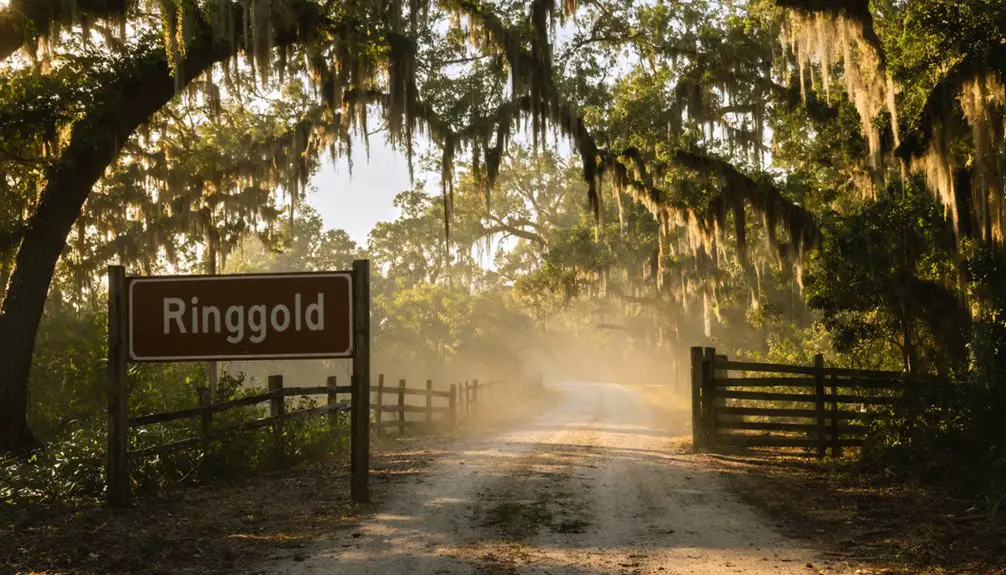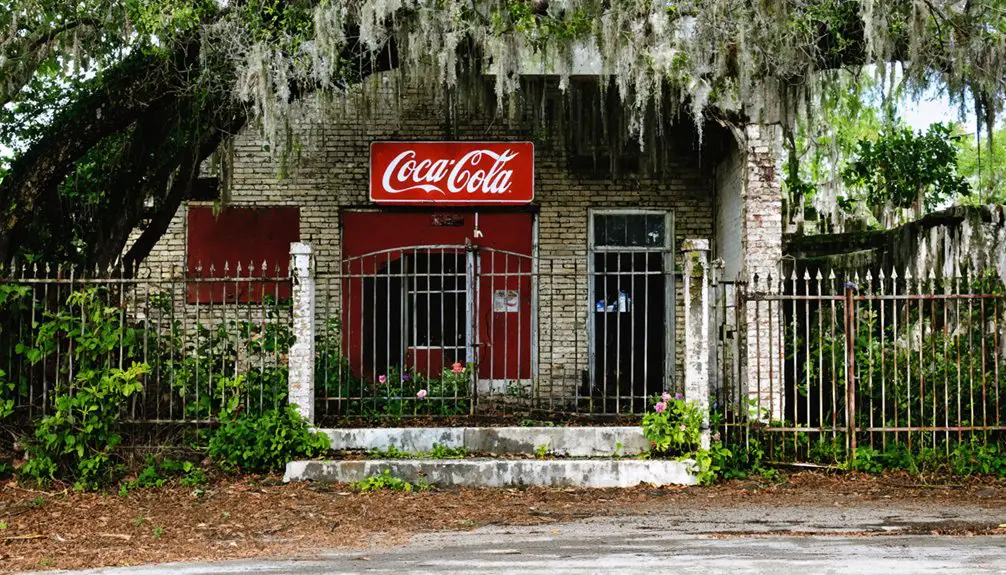You’ll find Ringgold’s remains in northern Hernando County, Florida at 28°39.1’N and 82°26.8’W. This former military and educational hub began as indigenous territory, later becoming a crucial crossroads after the Cherokee Nation permitted a federal road in 1805. By the late 1800s, the town thrived on lumber, turpentine, and phosphate industries before economic decline and natural disasters led to its abandonment. Today, scattered metal fragments and local supernatural tales preserve its frontier legacy.
Key Takeaways
- Ringgold was an early Florida settlement that declined after economic hardships, natural disasters, and resource depletion in the late 1800s.
- Located at 28°39.1’N and 82°26.8’W in northern Hernando County, the ghost town has few remaining physical structures.
- The area’s economy once thrived on lumber, turpentine, and phosphate industries before its eventual abandonment.
- Only scattered metal fragments and old nails remain visible, with the landscape returning to mixed pine and hardwood forests.
- Local supernatural legends and Civil War history persist through guided tours and educational programs about the abandoned settlement.
Historical Settlement and Origins
While indigenous peoples had inhabited the area since 1000 BC, Ringgold’s strategic location at the intersection of major valleys made it a natural crossroads for early travel and settlement.
Archaeological evidence reveals the presence of Mound Builders, who left their mark with a significant mound near the Alabama Road. The site’s unique geography connected the Mississippi Valley to the East Coast, shaping early transportation patterns through Ringgold Gap and Mill Creek Gap. The fort later became a significant educational hub for local families in the region.
Initially known as Cross Roads or Taylor’s Cross Roads, the settlement’s indigenous influence continued into the 1800s when the Cherokee Nation granted permission for a federal road in 1805. Similar to Fort Ringgold’s role as a critical military site, this location served as a vital checkpoint for early American expansion.
This essential thoroughfare branched toward Knoxville and Nashville, while the Cherokee people maintained the route, collecting tolls and establishing businesses to serve travelers.
Economic Rise and Decline
Although the town’s early economic development initially seemed modest, Ringgold’s extractive industries surged during the late 1800s through lumber operations, turpentine harvesting, and phosphate mining.
You’ll find this pattern mirrored across frontier Florida, where resource extraction drove rapid growth and attracted waves of settlers seeking opportunity. The region experienced similar boom-bust cycles as communities in the American West. Similar to the failed experiment at Rollestown, the town’s turpentine operations relied heavily on laborers from England.
Like many boom towns of its era, Ringgold’s prosperity proved vulnerable to economic cycles and resource depletion. The community established essential infrastructure including stores and communal buildings, but faced mounting challenges as natural resources dwindled.
When combined with natural disasters like floods and the devastating Great Freeze of 1894-95, these pressures triggered a familiar spiral of decline. Workers migrated away as opportunities faded, leaving behind abandoned buildings and infrastructure that once served this bustling frontier community.
Physical Remnants and Site Features
Today’s visitors to Ringgold’s former location will find few physical traces of this once-active frontier settlement. If you’re planning site exploration, you’ll encounter a landscape that’s largely returned to its natural state, with mixed pine and hardwood forests dominating the Hernando County terrain.
Similar to the logging town of Centralia ghost town, these sites share a common history of abandonment and natural reclamation. Like many of Iowa’s post office hubs that vanished, the land has completely reverted to wilderness.
- No standing structures remain, though you might spot scattered metal fragments or old nails.
- The flat, wooded landscape offers minimal archaeological potential without formal excavation.
- You’ll find no historical markers or developed trails to guide your visit.
- Natural vegetation has reclaimed any cleared areas from the settlement period.
- Access is primarily through rural roads, with no formal visitor infrastructure.
The site’s physical remnants are limited, leaving the ghost town‘s exact footprint a mystery for modern-day explorers to contemplate amid the Florida wilderness.
Local Stories and Cultural Heritage
Despite its vanished physical structures, Fort Ringgold’s legacy lives on through rich supernatural lore and cultural memory. You’ll find local legends woven into the community’s fabric, from tales of ghostly apparitions on parade grounds to unexplained phenomena in former officers’ quarters.
These cultural narratives serve as powerful links to the site’s complex history, encompassing Civil War conflicts, Buffalo Soldiers, and racial violence. The 33rd Alabama Regiment trained here before experiencing their first combat at Perryville, Kentucky.
Through guided tours and educational programs, you’re able to experience how these stories shape regional identity. Night-shift workers report flickering lights and self-opening doors, while community projects like UTRGV’s historical archaeology initiative help preserve these accounts.
The fort’s transformation from military outpost to school campus reflects a living heritage where supernatural beliefs and documented history intertwine, creating a multifaceted understanding of the past.
Geographical Location and Access

Nestled in northern Hernando County, Florida, Ringgold sits at coordinates 28°39.1’N and 82°26.8’W, where State Road 98 intersects with County Road 491.
Modern urban mapping reveals a transformed landscape from its historical roots, with transportation routes now connecting this rural crossroads to Brooksville and beyond. The DeChamps General Store remains as a testament to the area’s commercial past.
You’ll find these key features when visiting:
- 2WD-accessible roads suitable for standard vehicles
- Former stage stop converted to a convenience store
- Historic Stone School building repurposed as a library
- Scattered modern homesites around the original town location
- Year-round access, though summer heat can be intense
The site’s location in the Eastern Time Zone puts you within easy reach of Brooksville’s amenities while maintaining the freedom of rural Florida living. Area visitors can track daylight hours with dawn at 06:06 to plan their explorations effectively.
Legacy and Historical Significance
Although Fort Ringgold‘s military operations ceased in 1944, its enduring legacy spans multiple historical eras and continues to shape regional identity.
The military base was influenced by the famous Battle of Ringgold Gap when Confederate troops delayed advancing Union forces in 1863.
You’ll find its military significance woven through major conflicts, from the Mexican-American War to the Civil War, where it switched between Confederate and Union control.
The fort’s cultural impact deepened when it hosted Buffalo Soldiers in 1899, marking an essential chapter in racial integration.
Frequently Asked Questions
What Role Did Native Americans Play in the Early Development of Ringgold?
Like ancient roots nourishing new growth, you’ll find Native tribes – particularly Cherokee and Creek peoples – established essential trading routes, sacred spaces, and cultural influences that shaped Ringgold’s early foundation.
Are There Any Documented Paranormal Investigations or Ghost Hunting Expeditions?
You won’t find documented paranormal investigations of this location. While ghost tours and haunted attractions exist in the broader Ringgold area, there’s no verified evidence of official ghost hunting expeditions here.
Which Notable Historical Figures or Families Were Associated With Ringgold?
You’ll find notable residents like General Patrick Cleburne, who commanded troops in 1863, plus historic families including the Whitmans, Jones, and Evans, whose houses survived the Civil War’s destruction.
What Natural Disasters or Epidemics Contributed to the Town’s Abandonment?
Like a puzzle missing its key pieces, you won’t find any documented hurricane damage or disease outbreaks that caused Ringgold’s abandonment. Instead, it’s likely economic changes sealed the town’s fate.
Does Anyone Maintain Private Property Rights Within the Former Town Limits?
Yes, you’ll find active property ownership within the former town limits, with private landholders maintaining their rights under county jurisdiction. There aren’t any current legal disputes challenging individual property claims.
References
- https://www.utrgv.edu/newsroom/2024/10/31/haunted-history-of-the-rgv-fort-ringgold.htm
- https://freepages.history.rootsweb.com/~gtusa/usa/fl.htm
- https://www.journaloffloridastudies.org/0102ghosttowns.html
- https://www.youtube.com/watch?v=mz2bBRUsNuY
- https://www.appalachianhistory.net/2017/10/three-restless-spirits-of-sarah-will.html
- https://www.catoosachamberofcommerce.com/PDF/Ringgold.pdf
- https://www.cityofringgoldga.gov/CityHistory.aspx
- https://www.instagram.com/p/DBzMgbPPyop/?hl=en
- https://historiccity.com/2010/staugustine/news/historic-city-memories-ghost-towns-2510
- https://abandonedfl.com/the-town-of-ellaville/



